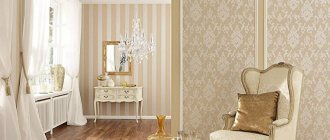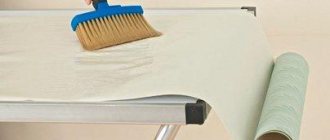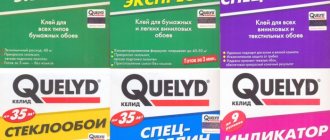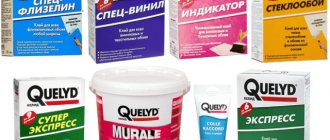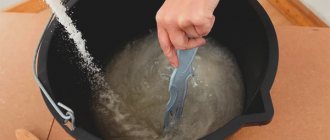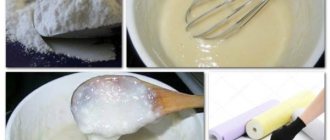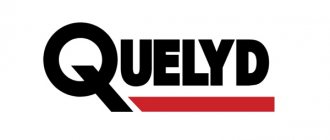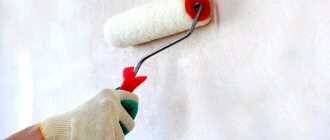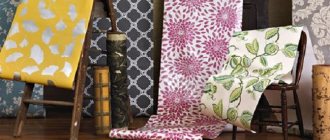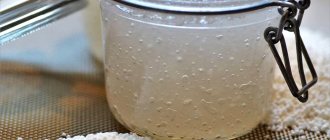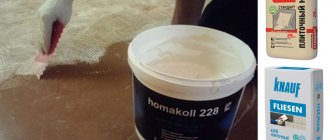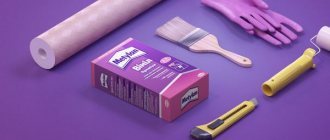9842 0 10
Andrey July 28, 2017 Specialization: facade finishing, interior finishing, construction of dachas, garages. Experience of an amateur gardener and gardener. We also have experience in repairing cars and motorcycles. Hobbies: playing the guitar and many other things that I don’t have time for :)
In Soviet times, PVA was often used for gluing wallpaper, but is such a solution justified in our time? To answer this question, I propose to understand all the features of this material, as well as all the pros and cons of its use.
Polyvinyl acetate glue can be used for wallpapering
What is the best glue to use for non-woven wallpaper?
The best adhesive for non-woven wallpaper: top 5 according to the editors
- Rules for choosing adhesive Non-woven wallpaper is quite easy to glue - it does not need to be soaked for a long time in compounds, like paper wallpaper. ...
- “Moment Non-woven”: cheap and cheerful...
- Metylan. ...
- Quelyd. ...
- Exclusive Non-Woven. ...
- Kleo.
16 Sep.
2022 Interesting materials:
What can you bake on a silicone mat? What can be written in 1 byte? What can you write in your reading diary? What can you put in chicken? What can you wrap in a roll? What can't vegetarians eat? What would happen to all objects on Earth If there were no gravity? Let's imagine the following picture: I have a button that can turn off universal gravity? What is ammonium and what can replace it? What is kindness and what can it do? What is a footer and where can it be located?
Cons of PVA
• The adhesive is very dense and cannot be applied evenly to the surface of the wallpaper. Therefore, you should not use PVA glue for gluing large panels of wallpaper. And special substances have been added to the wallpaper glue to promote slip and uniform application.
• Due to its dense consistency, PVA dries very unevenly. In addition, when drying, a film is formed, under which, in the case of an excessive amount of glue, a so-called bag of glue and air is formed. The wallpaper glue dries evenly and the wallpaper lays flat.
• The resulting film is not soluble in water. After the wallpaper has served its purpose and the time comes to remove it from the walls, it turns out that this is not so easy, since the film has tightly “soldered” it to the wall.
The listed disadvantages of PVA glue make it not the best choice for gluing wallpaper.
Conclusion
So we figured out what are the pros and cons of PVA, and in what cases does it make sense to use it. Additionally, watch the video in this article. And if you have any questions, contact me in the comments, and I will be happy to answer you.
Did you like the article? Subscribe to our Yandex.Zen channel
July 28, 2022
Wallpaper,Construction Chemicals
If you want to express gratitude, add a clarification or objection, or ask the author something, add a comment or say thank you!
Why is it not recommended to glue wallpaper with PVA glue?
Vinyl adhesive can be used for gluing a whole range of wall materials - paper, vinyl, embossed, fabric, velor, metal, bamboo, structural and paintable wood fiber wallpapers. At the same time, the sliding structure of the glue makes it easy to align and accurately match the pattern on the wallpaper. Before the glue dries completely, it is even possible to tear off the wallpaper and re-glue it without adding new glue.
The method of using vinyl adhesive for gluing wallpaper depends on the type of wallpaper itself.
On light paper wallpapers - both single-layer simplex and two-layer duplex - vinyl glue is applied once, and then they are immediately applied to the walls. When choosing heavier wallpaper, some uneven walls or porosity of the base, a different method of wallpapering is used. First, apply a layer of adhesive to the surface of the base and allow it to soak into the walls. Then, after a while, another layer is applied and only after that the wallpaper is glued to the wall.
Read also: Do tangerines grow in Azerbaijan
Vinyl adhesive is used on all types of mineral substrates: concrete, stone, plaster, brick, porous and non-porous substrates. Some types of glue also adhere well to laminate and ceramic tiles.
It is generally expected that these substrates should be cleaned, degreased and dried before adhesive is applied. However, having additional ingredients in its composition, vinyl adhesive is also effective when gluing vinyl, mineral, fiberglass and textile wallpaper and in places of high humidity. Thus, vinyl glue turns out to be a very necessary material when decorating a bathroom or kitchen with wallpaper.
Vinyl adhesive is used not only for finishing rooms with various types of wallpaper. It is also used for interior decoration with various decorative elements. Vinyl adhesive is effective for attaching polystyrene foam moldings and tiles to vertical and horizontal surfaces. In addition, water-dispersion vinyl adhesive is used for gluing composite parquet, panel parquet, laminate and floating parquet. The flooring can be combined with either a base surface or a cork underlay. This adhesive is also used for gluing laminate and veneer.
Vinyl adhesive is very popular in woodworking and furniture production. Transparent, quick-drying adhesive is effectively used for end-to-end jointing of prefabricated furniture, both conventional and intended for wet areas. A reliable adhesive with an aesthetically pleasing end result and ease of use, it is common and available for home use.
Vinyl adhesive is not exclusive to the construction industry. Vinyl-based adhesives are also successfully used in everyday life for minor repairs. They quickly and efficiently fasten products made from paper, cardboard, wood, plastic, and ceramics. And such properties of vinyl adhesives as transparency, optimal setting speed, environmental friendliness and efficiency in relation to various materials allow them to be used for decorative purposes - to create wooden mosaics or gluing beads and other decoration elements to different types of fabric. Thus, vinyl adhesive is used both in educational institutions and in the design field.
Properties of vinyl adhesive
The popularity and productivity of vinyl glue - both as an adhesive and as an independent substance - are associated with its properties:
• high efficiency in relation to a wide range of different materials, the ability to carry out a variety of finishing works with one glue; • simplicity and accessibility of use. Depending on the consistency, the adhesive is ready for use immediately or you just need to stir it in cold water (almost all varieties are instant); • high sliding ability allows the joining of materials to be joined as accurately as possible; • after drying, the glue becomes transparent, does not leave stains or lumps, does not turn yellow or become brittle; • very resistant to moisture, which significantly expands the scope of its application; • resistant to high and low temperatures, non-flammable; • in dry form the shelf life is practically unlimited; in the form of a ready-made mixture it can retain adhesive properties for about a week; • the bactericidal and antifungal components contained in the composition prevent the primary formation of mold and mildew; • safe for the environment and human health, has a neutral alkaline level - does not irritate the skin.
The disadvantages of vinyl adhesive are most often associated with its unreasonable use. Designed primarily to work alongside heavy wallpaper, using vinyl adhesive with lighter finishing materials may be impractical and uneconomical. Another, but this time objective negative characteristic of vinyl adhesive is its low air permeability (not a “breathable” material). Therefore, vinyl adhesive is more often used in functional, non-residential premises.
However, the advantages of vinyl adhesive far outweigh its disadvantages, which makes it one of the very popular construction and household adhesives.
Conditions of use and storage
It is important not only to choose the appropriate composition for a specific task, but also to store and apply it correctly in order to obtain a high-quality result.
- Store PVA glue in a dry room at a positive temperature.
- It is important to tightly close the container with glue, otherwise the composition may thicken and dry out.
- The average shelf life of the glue is 6 months from the date of its release. Expired glue thickens, dries over time and loses its properties.
- The finished PVA glue mixture must be used within 20-40 minutes, since after this time it begins to thicken and dry. The exception is stationery glue, which is produced in small quantities. It can be used for six months, closing after each use.
- To ensure the strength of the joint, the surfaces must be degreased before gluing. It is important to remember that the maximum gluing effect is achieved after 24–36 hours.
- Hardened adhesive can be removed with any available solvent, such as gasoline, turpentine, white spirit or ammonia. If the stain is fresh, try wiping it off with a cloth soaked in vodka or vinegar.
- Tools and working glue containers are easily washed with water, and contaminated water is safe for wastewater.
Some features
If the wallpaper was glued with regular glue, then you can simply remove it by first separating the top layer.
Then the base can be soaked and easily removed with a spatula. When gluing was carried out using dispersion adhesive, the finishing from the walls had to be scraped off with great difficulty. It is recommended not to do this, because this option is not the best method, as it can damage the surface.
You need to know that after gluing with PVA, it is very difficult to remove the finish. This is a waterproof glue, and wallpaper glued with it cannot simply be soaked and removed from the surface. You have to work with a spatula, damaging the wall covering. If the surface is made of plasterboard, then it will suffer very seriously. In order to obtain a new base suitable for pasting, it will have to be puttied and leveled a lot and for a long time.
PVA is more expensive than regular wallpaper glue, which is more suitable for these purposes. You can add a little dispersion glue (0.5 liters per 10 liters), the wallpaper will stick better and stick more securely. For joints, you can dilute PVA glue with water in the proportion of 2 parts glue and 1 part water. Then it will be easier to apply it to the surface. The adhesive strength is significantly higher than when gluing with simple wallpaper glue.
How to dilute with water depending on the type
PVA glue can be used for household use, office use, or dry glue. The first two species have a similar structure, so their dilution with water is carried out according to the same scheme. In order for the base to retain its properties and not lose its ability, it is important to carry out everything in stages.
How to dilute stationery and household supplies
You can dissolve PVA quickly and without problems, but it is still worth preparing for this process. To carry out the work, you will need slightly warm water; you can first collect it and leave it to stand at room temperature.
If the PVA glue has thickened, then its dilution should be carried out as follows:
- First, prepare a container for stirring and dissolving;
- Next, the product is laid out in it and a little water is added;
- Using a spatula, mix until a homogeneous consistency is formed;
- Afterwards everything is left to settle for a while.
The mixture should not be used immediately, otherwise it may damage the product. It is advisable to leave the glue for half an hour after dilution; this time will be enough for it to acquire the desired structure.
If PVA is used to prime cement walls, then the volume of water should be several times larger.
How to dilute dry
Wallpaper glue is sold as a dry powder. Its dilution must be carried out in accordance with the instructions indicated on the packaging. But it happens that there are leftovers at home, but the preparation diagram is not at hand.
We suggest considering the rules for diluting the powder:
- When preparing, be sure to follow the proportions - add 1 liter of warm water per 100 grams of powder;
- It needs to be diluted in a special plastic container;
- Stir thoroughly, breaking up lumps;
- You should get a homogeneous mixture similar to sour cream.
If it is used for priming walls, then it is worth adding twice as much water. The mixture should be very liquid.
All of the above recommendations will help restore the glue and return it to its original properties. But it’s still worth doing it correctly in compliance with proportions and rules. There is no need to throw away the product, just add a little water and the composition will again become suitable for repair and office work. In the video below you can see the reverse method.
Source
General information
This process formed the basis of the opinion about its strength and reliability, as well as the possibility of using it for gluing wallpaper. It is precisely due to its strength properties that most people try at all costs to add PVA glue to a simple wallpaper adhesive composition or even glue the canvases with pure PVA. But should this be done, and what result can it lead to? This article will describe this situation in detail.
PVA glue parameters that prevent it from being used for wallpaper
But there are many disadvantages, due to which it is better not to use this type for repair work using wallpaper:
- The composition is very thick, which will result in uneven drying of the treated surface. It is very difficult to level the canvas on the surface under such conditions. Even the use of high-quality PVA glue does not give the same result as using wallpaper, because the latter is distinguished by the fact that it glides very well, which makes it possible to install the canvas on the wall in the way intended and required. Special particles are added to the wallpaper adhesive composition, which give it such a quality that allows it to stick the canvas as best as possible.
- As mentioned earlier, the PVA adhesive composition dries out over a longer period of time and at the same time unevenly. If it is coated with a very thin layer, it will quickly polymerize, but in a thick layer a film appears from the inside, which will prevent water from evaporating from certain parts of the layer, and thereby spending a long time on drying certain areas.
- The composition of the polyvinyl acetate type is finely dispersed, and therefore gluing wallpaper with it on rough surfaces is not so convenient and is simply impossible, because it does not fill voids. Wallpaper adhesive is made from a large number of large cellulose fibers, which makes it possible to glue the canvas even to uneven surfaces.
- After the pasting composition dries, it will become like plastic and will firmly hold the previously glued wallpaper. If you need to do repeated repair work, it will be almost impossible to remove this coating.
Because of these qualities, the use of polyvinyl acetate when wallpapering is undesirable. But there are situations when such a tool is simply irreplaceable during repair work:
Peeling off joints - the finished coating, on which the joints have begun to peel off, can be coated with PVA glue and waited for a few minutes, and then pressed together. Afterwards the joints will be glued tightly.
It is also worth listening to the advice of the masters.
Recommendations for the pasting process
For high-quality gluing, it is also worth coating the canvases without dry spots and with precise processing of the joints. It is better not to stretch the canvas when gluing it. If you add PVA to the adhesive composition, you can improve the quality of adhesion, but this is only available for heavy and durable coatings. From such an additive, paper products may begin to turn yellow and become tougher.
Only those who have tried to improve a thin coating with this type of adhesive are familiar with this property. After a couple of years, as the temperature changes, the stains will reveal themselves and ruin the appearance of the home, which will lead to repeated repairs.
At the moment, manufacturing companies offer a newer composition, namely “Wallpaper polyvinyl acetate”, which was able to combine the qualities of two adhesive compositions, and therefore it can be used for heavy wallpaper if there is no opportunity and desire to experiment with additives. It has proven itself to be excellent, but it is not necessary to use it; everyone will choose what is easier and closer to them. And it costs much more than wallpaper adhesive.
Advantages and disadvantages
A primer made from PVA glue has its advantages and disadvantages. The undoubted advantages are:
- Increased adhesion. An additional layer is created to securely fix the finish to the surface.
- Reduced moisture absorption. The soil penetrates the surface structure, filling its pores and preventing moisture from entering them.
- Creation of a protective layer. A thin polymer barrier helps combat aggressive environmental influences.
- Reducing the amount of consumables (plaster, paint, glue).
In addition, a primer made from PVA ensures even application of paint and facilitates the process of wallpapering. Of course, all this is sufficiently ensured by commercial primer, which is available in a wide range. But often its high price forces us to look for more profitable solutions. Therefore, using PVA instead of a primer is a completely justified option.
Despite all the advantages, this composition still has disadvantages. These include:
- Ineffectiveness – insufficient penetration into the depth of the material.
- Lack of antiseptic properties - the primer coating will not be able to resist the proliferation of microorganisms (mold, fungus).
- The formation of yellow spots and stains spoils the appearance of the finish.
- The material loses its properties in damp rooms - it is not used to cover walls, ceilings in bathhouses, swimming pools.
Knowing some subtleties, you can turn disadvantages into advantages and improve the properties of an aqueous PVA solution for priming walls. So, for example, you can increase the ability to resist mold by adding a little whiteness to the composition in the proportion: 50 g of disinfectant per liter of ready solution. If you add 3% of its volume of liquid glass to PVA soil, you can increase the permeability of the material being processed, especially wooden bases.
Recommendations for pasting
You shouldn’t complicate the repair process by gluing wallpaper on PVA; it’s better to choose a suitable wallpaper composition. Now the construction market offers a huge number of different types of adhesive compositions for any wallpaper. They will cope with the pasting with a bang. The main thing is to read the instructions on the package and dilute the mixture as indicated there. Also, proper coating of the canvas, without leaving dry spots, and precise processing of the joints will help in better quality pasting. There is no need to stretch the canvas when gluing it.
If you add PVA to the adhesive composition, you can improve the quality of adhesion, but this is possible, as mentioned earlier, only for high-quality durable and heavy coatings. Paper products from such an additive may begin to turn yellow and become tougher. Those who have tried to correct a thin coating with this type of adhesive are well aware of this property. After 2–3 years, under conditions of changing temperatures, such stains reveal themselves and spoil the entire appearance of the home, forcing the owners to carry out repeated repairs.
Now manufacturers are offering a new composition - this is polyvinyl acetate “Wallpaper”, which combines the qualities of two adhesive compositions, so for heavy wallpaper you can use it if there is no opportunity or desire to experiment with additives. It has already proven itself well, but it is not necessary to stick with it; everyone here chooses what is closer and easier for them. And this composition costs more than wallpaper glue for this type of canvas.
Main characteristics
Dispersion adhesive consists of small polymer particles mixed with water. When the moisture evaporates, a homogeneous film is formed - polymerization occurs. After this, it cannot be dissolved with water.
Compared to simple wallpaper, this adhesive has significantly higher adhesive strength. These features have pros and cons:
- fairly thick consistency;
- composition features;
- uneven drying.
Spread wallpaper is very difficult to level due to its thick consistency. Thanks to the addition of special components, wallpaper adhesives allow the canvas to slide over the surface being pasted. PVA does not have such properties, so gluing wallpaper on it is quite difficult. It can be used to glue joints.
The adhesive contains rather long cellulose fibers, which do not allow wallpaper to be properly glued to rough and porous surfaces. It is not able to properly fill the pores of the substrate.
PVA is characterized by the fact that it dries for a long time and rather unevenly. Where there is a thin layer of glue, a polymer film forms very quickly. In those places where a thick layer has formed, a film “bag” can be created that does not allow air to pass through well. Therefore, the glue takes quite a long time to dry.
How to remove paper wallpaper from walls?
Before you shoot
the wallpaper
with a knife or a roller with needles , then wet it well with liquid or water and leave for several hours so that the moisture seeps under the polymer layer and destroys the glue.
A horizontal cut is made at the top with a knife - and the wallpaper
is removed in whole strips when you pull it by the edge.
Interesting materials:
How to return a car to a car dealership? How to return an array in Java? How to return a mattress to the store? How to return furniture of inadequate quality? How to return a multicooker to a store in Ukraine? How to bring hidden shortcuts back to the screen? How to return the funded part of a pension to a pensioner? How to return savings to the State Pension Fund? How to return a wristwatch to the store? How to restore flash drive settings?
Surface preparation
The quality and durability of wall finishing with modern types of wallpaper is largely determined by the level of surface preparation. First of all, this applies to non-woven trellises, although another point of view is widespread among non-professionals that they can be glued to old wallpaper.
From a technological point of view, this approach is possible - the non-woven fabric is lightweight and the glue will always hold it on the trellises that have expired. But from an aesthetic point of view, this finishing option is impossible - the old pattern will be very clearly visible through the newly pasted sheets, unless, of course, the previous wallpaper is plain and light in color.
The entire process of preparing walls for wallpapering is discussed in detail in the work “How to prepare walls for wallpapering.” Let us briefly recall what was discussed there.
Before decorating an apartment with wallpaper, it is necessary to perform the following work sequentially:
- clean the walls of old finishes and, if necessary, plaster;
- repair the resulting microcracks, peelings, cavities, etc.;
- prime the surface;
- level uneven walls with cement-sand or dry (plasterboard, plywood, etc.) plaster;
- putty the surface of the plaster;
- treat the surface on which the trellises are glued with a primer.
What glues
What can you glue with PVA:
- cardboard, paper;
- wallpaper on textile, paper, non-woven, vinyl base;
- wooden sheets, blanks;
- skin;
- glass with porcelain;
- linoleum, some other finishing materials.
PVA glue has universal properties and applications. It can be added to ready-made mixtures for installing tiles and bricks. PVA is found in some household chemicals and paints. It provides a secure grip, non-toxic and safe. What is the best PVA glue? It all depends on the areas and purposes of use. We recommend paying a little more and ordering proven products. Well-known brands guarantee optimal composition and compliance with current industry standards.
